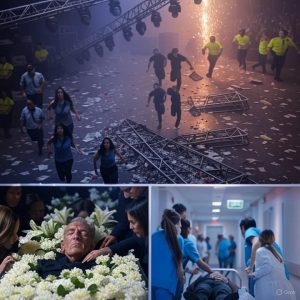The roar of “Born to Run” froze mid-chorus as a massive rig crashed onto Bruce Springsteen’s Madrid stage, turning joy into terror in an instant. Fans watched in horror as the legend collapsed, steel and sparks raining down, forcing thousands to flee in panic. The electrifying concert, meant to unite, became a nightmare as emergency crews fought through chaos to reach him—only for doctors to confirm the unthinkable: The Boss was gone. Sirens wailed as injured fans were treated, their disbelief mirroring a world stunned by the loss. Could this tragedy reshape his towering legacy? As the dust settles, questions linger about that fatal night, pulling us deeper into a story that refuses to fade.
Madrid erupted in screams and chaos as one of music’s greatest icons, Bruce Springsteen, lost his life in a devastating stage accident. What began as a night of electrifying music and celebration instantly turned to horror when a massive rig collapsed mid-performance during his legendary hit “Born to Run.”

Witnesses describe a scene of pandemonium: steel beams and sparks rained down on the stage, sending fans into a frantic scramble for safety. The roar of thousands of voices froze mid-chorus as panic rippled through the crowd. Emergency crews rushed to the scene, navigating through chaos to reach the fallen star. Despite their efforts, doctors confirmed the unthinkable—Bruce Springsteen, “The Boss,” was gone.
The impact of the tragedy rippled far beyond Madrid. Fans across the globe expressed shock and disbelief as footage of the collapse circulated online. Social media lit up with tributes, memories, and stunned reactions from those who had witnessed the concert or admired Springsteen’s decades-long career. His music, known for its raw energy and storytelling, had united generations—but that night, it became a haunting backdrop to an unthinkable loss.
Authorities are investigating the incident to determine how such a catastrophic failure occurred. Preliminary reports suggest structural issues with the stage rig, but no official cause has yet been confirmed. Safety protocols and concert logistics are now under intense scrutiny as the music world grapples with the implications of this disaster.
Fans who survived the incident describe the scene as surreal. “One moment we were singing, the next everything collapsed around us,” said a concertgoer. “It felt like the music died with him.” Psychologists note that witnessing such traumatic events can leave lasting emotional scars, particularly when they involve figures as beloved as Springsteen.
As tributes pour in, the music community reflects not only on his death but on the legacy he leaves behind. Bruce Springsteen’s career spanned decades, influencing countless artists and touching the lives of millions through his lyrics, performances, and activism. That legacy, though now marked by tragedy, remains indelible.
Questions linger about the fatal night: Could this accident have been prevented? What will it mean for large-scale live performances moving forward? And most importantly, how will fans remember the man whose music defined so many lives?
Madrid mourns, the world mourns, and as the dust settles, Bruce Springsteen’s sudden death becomes a stark reminder of life’s fragility—even for legends who seem larger than life.
Leave a Reply